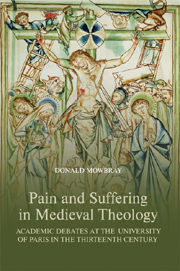 Pain and Suffering in Medieval Theology
Pain and Suffering in Medieval Theology Book contents
- Frontmatter
- Contents
- Acknowledgements
- Abbreviations
- Dedication
- Introduction
- 1 Thirteenth-Century Theological Ideas about Human Pain and Suffering and the Passion of Christ
- 2 Gendering Pain: Theological Ideas about Female and Male Suffering
- 3 Pain as a Restorative Power: Voluntary Suffering and Satisfaction for Sin
- 4 The Intellectual Development of Limbo: Pain, Children and Original Sin
- 5 Anima Separata: Masters of Theology and the Controversy surrounding the Suffering of the Separated Soul
- 6 Defining the Corporeal: Suffering in Hell according to Masters of Theology at Paris, c.1230–c.1280
- Conclusion
- Select Bibliography
- Index
3 - Pain as a Restorative Power: Voluntary Suffering and Satisfaction for Sin
Published online by Cambridge University Press: 12 September 2012
- Frontmatter
- Contents
- Acknowledgements
- Abbreviations
- Dedication
- Introduction
- 1 Thirteenth-Century Theological Ideas about Human Pain and Suffering and the Passion of Christ
- 2 Gendering Pain: Theological Ideas about Female and Male Suffering
- 3 Pain as a Restorative Power: Voluntary Suffering and Satisfaction for Sin
- 4 The Intellectual Development of Limbo: Pain, Children and Original Sin
- 5 Anima Separata: Masters of Theology and the Controversy surrounding the Suffering of the Separated Soul
- 6 Defining the Corporeal: Suffering in Hell according to Masters of Theology at Paris, c.1230–c.1280
- Conclusion
- Select Bibliography
- Index
Summary
The importance which theologians attached to painful means of redemption from sin was, it seems, immense. Christ as a model of suffering to be imitated is most often associated with the fifteenth century and most particularly with Thomas à Kempis. However, the links between human and divine suffering were of especial interest to theologians in the thirteenth century. A framework of explanation was required which would encompass the suffering of humans, on the one hand, and the divine on the other. Where Christ was concerned, theologians performed a delicate balancing act to resolve apparent contradictions within his human and divine natures, and to account for his voluntary acceptance of suffering for the sins of humankind. I have outlined this in Chapter 1.
However, when it came to human suffering, taken on in a voluntary capacity, the masters had another set of issues which necessitated attention. First, suffering was repugnant to both body and soul. Second, the sufferings of soul and body were different and each experienced pain in its own way and to its own degree of intensity. Third, how could suffering prevent disorder in the soul and body when pain itself caused disruption and corruption? These issues clearly required clarification if suffering were to be afforded beneficial status to a sinner. Suffering voluntarily had been part of penitential practice for centuries and it appears that it required more detailed explanation and even justification.
- Type
- Chapter
- Information
- Pain and Suffering in Medieval TheologyAcademic Debates at the University of Paris in the Thirteenth Century, pp. 61 - 80Publisher: Boydell & BrewerPrint publication year: 2009


